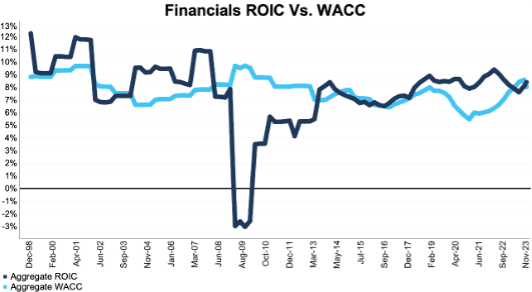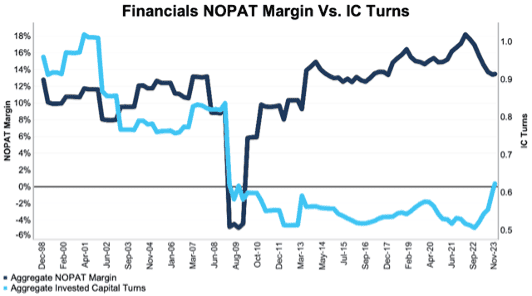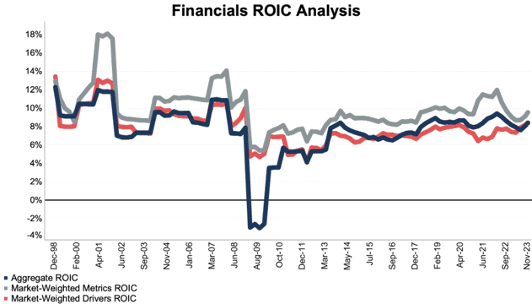We have updated the trailing-twelve-month (TTM) return on invested capital (ROIC) for the NC 2000 and all sectors for 3Q23.
It appears the Fed’s “higher for longer” interest rate policy has had the intended effect. As long as rates stay elevated, we expect ROIC to fall more before it rises significantly. Over the last several quarters, we are seeing a clear trend that ROIC peaked in 2Q22.
Seven out of eleven NC 2000 sectors saw a QoQ rise in the trailing-twelve-month (TTM) return on invested capital (ROIC) in 3Q23.
This report is an abridged and free version of All Cap Index & Sectors: ROIC Update For 3Q23, one of our quarterly reports on fundamental market and sector trends. The full reports are available to our Professional and Institutional members or can be purchased below.
The full version of this report analyzes[1],[2] the drivers of economic earnings [ROIC, NOPAT margin, invested capital turns, and weighted average cost of capital (WACC)] for the NC 2000, our All Cap Index, and each of its sectors (last quarter’s analysis available here).
This report leverages our cutting-edge Robo-Analyst technology to deliver proven-superior[3] fundamental research and support more cost-effective fulfillment of the fiduciary duty of care.
NC 2000 ROIC Analysis for 3Q23
Figure 1 in the full report shows the NC 2000’s ROIC every quarter over the last twenty years. We provide the same analysis for the NC 2000 and its eleven sector's NOPAT margin and invested capital turns.
Key observations:
In our 1Q22 report, we wrote that the “record” return on invested capital of 1Q22 was a mirage and that the bullish rise in ROIC would reverse soon. These 3Q23 results continue to support our thesis. NOPAT margins have now fallen to pre-COVID levels, but are still much higher than historical averages. As companies continue to report that margins remain under pressure, we expect ROIC could continue to fall further.
WACC for the NC 2000 rose QoQ again. With the Fed signaling a “higher for longer” scenario, WACC may remain high for quite some time. The high cost of capital rightfully undermines investor confidence in the viability of many weaker companies, several of which we’ve highlighted in our Zombie Stocks reports.
Beneath the surface, performance by sector is all over the map. Per Figure 2, some sectors saw ROIC rise while others saw it fall. Digging deeper and looking at the drivers of ROIC, NOPAT margins and invested capital turns, we see wildly different results in different sectors.
This variance signals a lot of churn at the company level, which we expect will weed out many weaker companies throughout the remainder of 2023 and into 2024.
See Figure 1 in the full version of our report for the chart of ROIC and WACC for the NC 2000 from December 1998 through 11/14/23.
Sneak Peak on Select NC 2000 Sectors
The Financials sector performed best in the third quarter of 2023 as measured by change in ROIC. The biggest loser in the third quarter was the Energy sector.
Below, we highlight the Financials sector, which had the largest QoQ increase in ROIC in 3Q23.
Sample Sector Analysis[4]: Financials
Figure 1 shows the Financials sector’s ROIC rose from 7.8% in 2Q23 to 8.4% in 3Q23. The Financials sector’s NOPAT margin rose from 13.3% in 2Q23 to 13.5% in 3Q23, while invested capital turns rose from 0.59 to 0.62 over the same time.
Figure 1: Financials ROIC vs. WACC: Dec 1998 – 11/14/23
Sources: New Constructs, LLC and company filings.
The November 14, 2023 measurement period uses price data as of that date for our WACC calculation and incorporates the financial data from 3Q23 10-Qs for ROIC, as this is the earliest date for which all of the 3Q23 10-Qs for the NC 2000 constituents were available.
Figure 2 compares the trends in NOPAT margin and invested capital turns for the Financials sector since December 1998. We sum up the individual NC 2000/sector constituent values for revenue, NOPAT, and invested capital to calculate these metrics. We call this approach the “Aggregate” methodology.
Figure 2: Financials NOPAT Margin and IC Turns: Dec 1998 – 11/14/23
Sources: New Constructs, LLC and company filings.
The November 14, 2023 measurement period uses price data as of that date for our WACC calculation and incorporates the financial data from 3Q23 10-Qs for ROIC, as this is the earliest date for which all of the 3Q23 10-Qs for the NC 2000 constituents were available.
The Aggregate methodology provides a straightforward look at the entire sector, regardless of market cap or index weighting and matches how S&P Global (SPGI) calculates metrics for the S&P 500.
For additional perspective, we compare the Aggregate method for ROIC with two other market-weighted methodologies: market-weighted metrics and market-weighted drivers. Each method has its pros and cons, which are detailed in the Appendix.
Figure 3 compares these three methods for calculating the Financials sector’s ROICs.
Figure 3: Financials ROIC Methodologies Compared: Dec 1998 – 11/14/23
Sources: New Constructs, LLC and company filings.
The November 14, 2023 measurement period uses price data as of that date for our WACC calculation and incorporates the financial data from 3Q23 10-Qs for ROIC, as this is the earliest date for which all of the 3Q23 10-Qs for the NC 2000 constituents were available.
This article was originally published on December 6, 2023.
Disclosure: David Trainer, Kyle Guske II, Italo Mendonça, and Hakan Salt receive no compensation to write about any specific stock, style, or theme.
Questions on this report or others? Join our Society of Intelligent Investors and connect with us directly.
Appendix: Analyzing ROIC with Different Weighting Methodologies
We derive the metrics above by summing the individual NC 2000/sector constituent values for revenue, NOPAT, and invested capital to calculate the metrics presented. We call this approach the “Aggregate” methodology.
The Aggregate methodology provides a straightforward look at the entire sector, regardless of market cap or index weighting and matches how S&P Global (SPGI) calculates metrics for the S&P 500.
For additional perspective, we compare the Aggregate method for ROIC with two other market-weighted methodologies:
- Market-weighted metrics – calculated by market-cap-weighting the ROIC for the individual companies relative to their sector or the overall NC 2000 in each period. Details:
- Company weight equals the company’s market cap divided by the market cap of the NC 2000/its sector
- We multiply each company’s ROIC by its weight
- NC 2000/Sector ROIC equals the sum of the weighted ROICs for all the companies in the NC 2000/each sector
- Market-weighted drivers – calculated by market-cap-weighting the NOPAT and invested capital for the individual companies in the NC 2000/each sector in each period. Details:
- Company weight equals the company’s market cap divided by the market cap of the NC2000/its sector
- We multiply each company’s NOPAT and invested capital by its weight
- We sum the weighted NOPAT and invested capital for each company in the NC 2000/each sector to determine the NC 2000/sector’s weighted NOPAT and weighted invested capital
- NC 2000/Sector ROIC equals weighted NC 2000/sector NOPAT divided by weighted NC 2000/sector invested capital
Each methodology has its pros and cons, as outlined below:
Aggregate method
Pros:
- A straightforward look at the entire NC 2000/sector, regardless of company size or weighting.
- Matches how S&P Global calculates metrics for the S&P 500.
Cons:
- Vulnerable to impact of by companies entering/exiting the group of companies, which could unduly affect aggregate values despite the level of change from companies that remain in the group.
Market-weighted metrics method
Pros:
- Accounts for a firm’s size relative to the overall NC 2000/sector and weights its metrics accordingly.
Cons:
- Vulnerable to outsized impact of one or a few companies. This outsized impact tends to occur only for ratios where unusually small denominator values can create extremely high or low results.
Market-weighted drivers method
Pros:
- Accounts for a firm’s size relative to the overall NC 2000/sector and weights its NOPAT and invested capital accordingly.
- Mitigates potential outsized impact of one or a few companies by aggregating values that drive the ratio before calculating the ratio.
Cons:
- Can minimize the impact of period-over-period changes in smaller companies, as their impact on the overall sector NOPAT and invested capital is smaller.
[1] Calculated using SPGI’s methodology, which sums up individual NC 2000 constituent values for NOPAT and invested capital. See Appendix III for more details on this “Aggregate” method and Appendix I for details on how we calculate WACC for the NC 2000 and each of its sectors.
[2] This report is based on the latest audited financial data available, which is the 3Q23 10-Q in most cases. Price data as of 11/14/23.
[3] Our research utilizes our Core Earnings, a more reliable measure of profits, as proven in Core Earnings: New Data & Evidence, written by professors at Harvard Business School (HBS) & MIT Sloan and published in The Journal of Financial Economics.
[4] The full version of this report provides the same analysis for all eleven sectors.



